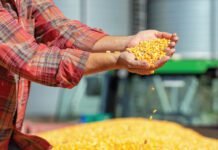After the recent implementation of the ban on white rice exports, the Centre has now moved exports of de-oiled rice bran (DORB) into the ‘prohibited’ category from the previously unrestricted ‘free’ category, according to a notification issued by the Directorate General of Foreign Trade (DGFT) recently.
The decision to restrict DORB exports until 30 November was prompted by a significant increase in domestic milk and milk product prices, primarily due to soaring fodder prices. DORB plays a vital role as a key ingredient in cattle, poultry, and fish feed, with approximately 25% being used in cattle feed.
In 2022-23, India produced a record 5.5 million tonnes of DORB as against the previous year’s 5 million tonnes, according to the government’s estimates. However, only 600,000 tonnes of the total 5.5 million tonnes (~12%) was exported.
Notably, West Bengal stands as a significant producer of DORB. But the eastern part of the country lacks a substantial cattle feed industry and demand for the product, resulting in exports becoming the main outlet for the disposal of DORB.
The Solvent Extractors’ Association of India (SEA) presented documents to the government explaining the challenges faced, particularly the high local freight costs for transporting DORB from eastern India to the southern and western parts of the country. “This will do irreparable damage not only to the oilseed sector but also to the oilseed farmer. It will also hit the rice milling industry and production of rice bran oil,” SEA executive director B.V. Mehta said.
As far as the impact of the rice bran extraction ban is concerned to reduce milk and milk products prices, “even if the price of the cattle feed is reduced say by 10%, cattle feed value may reduce by 2.5% and ultimately the milk price will reduce not more than 1%,” explained Mehta.
“However, there are numerous factors apart from feed ingredient cost including packaging, transport, etc. responsible for the milk and milk products prices,” Mehta added.
Retail milk prices have shot up nearly 22% in three years, including about 10% in the last year due to affected artificial insemination in animals resulting in lower calf birth and consequently a decline in milk production.
“Milk production was also affected because farmers were unable to take care of animals well in the pandemic when commodities prices shot up influencing fodder prices. This left a significant impact on overall milk productivity which then manifested in shortages of ghee, butter, etc. over a year and a half. As a result, we have seen a significant hike in milk prices, and this year, too, we are expecting a 4-5% year-on-year rise in FY24,” Crisil director Pushan Sharma told earlier this month in an interview.
Source: The Mint













